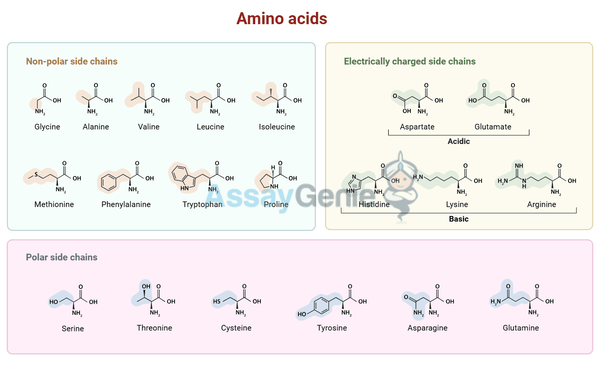Amino Acids: Functions, Roles, and Structures
Amino acids are the fundamental units of proteins, playing critical roles in virtually every biological process. Composed of a central carbon atom bonded to an amino group (-NH₂), a carboxyl group (-COOH), a hydrogen atom, and a unique side chain (R-group), amino acids are classified based on their side chain properties and functions. This article explores the 20 standard amino acids, describing their functions and providing a detailed chart with their structures.
1. The Roles of Amino Acids
Amino acids contribute to numerous physiological processes beyond protein synthesis.
Key Functions:
- Protein Building: Combine in various sequences to form proteins essential for cellular structure and function.
- Energy Production: Can be converted to glucose (gluconeogenesis) or ketones (ketogenesis) for energy.
- Neurotransmitter Precursors: Some amino acids, like tryptophan and tyrosine, are precursors to neurotransmitters such as serotonin and dopamine.
- Immune Function: Aid in the production of antibodies and immune cell activity.
- Hormone Synthesis: Precursor for hormones like thyroid hormones (tyrosine) and melatonin (tryptophan).
2. Classification of Amino Acids
By Essentiality:
- Essential Amino Acids: Cannot be synthesized by the body; must be obtained through diet.
- Non-Essential Amino Acids: Synthesized by the body but still vital for protein structure.
By Side Chain Properties:
- Non-Polar (Hydrophobic): Often found in protein interiors.
- Polar (Hydrophilic): Involved in interactions with water and other polar molecules.
- Acidic (Negatively Charged): Contribute to ionic bonding and protein stability.
- Basic (Positively Charged): Participate in catalysis and binding.
3. Amino Acids Chart: Functions and Structures
Below is a comprehensive chart that lists all 20 standard amino acids, their structures, and their biological roles.
Amino Acid | Abbreviation | Structure | Category | Functions |
|---|---|---|---|---|
Alanine | Ala (A) |  | Non-Polart | Glucose-alanine cycle for energy; stabilizes protein cores. |
Arginine | Arg (R) |  | Basic | Precursor for nitric oxide, critical for vasodilation. |
Asparagine | Asn (N) |  | Polar (Uncharged) | Glycoprotein synthesis and nitrogen metabolism. |
Aspartic Acid | Asp (D) |  | Acidic | Involved in the urea cycle and neurotransmitter synthesis.t |
Cysteine | Cys (C) |  | Polar (Uncharged) | Forms disulfide bonds, stabilizing protein structure. |
Glutamic Acid | Glu (E) |  | Acidic | Acts as an excitatory neurotransmitter. |
Glutamine | Gln (Q) |  | Polar (Uncharged) | Crucial for nitrogen transport and acid-base balance. |
Glycine | Gly (G) |  | Non-Polar | Key in collagen structure and central nervous system function. |
Histidine | His (H) |  | Basic | Precursor to histamine; involved in enzymatic reactions. |
Isoleucine | Ile (I) |  | Non-Polar | Important for muscle repair and hemoglobin synthesis. |
Leucine | Leu (L) |  | Non-Polar | Stimulates muscle protein synthesis via mTOR activation. |
Lysine | Lys (K) |  | Basic | Aids in collagen cross-linking and carnitine production. |
Methionine | Met (M) |  | Non-Polar | Methyl donor for metabolism and initiates protein synthesis. |
Phenylalanine | Phe (F) |  | Non-Polar | Precursor to tyrosine, dopamine, and epinephrine. |
Proline | Pro (P) |  | Non-Polar | Stabilizes proteins by introducing kinks in the structure. |
Serine | Ser (S) |  | Polar (Uncharged) | Active in metabolic pathways and cell signaling. |
Threonine | Thr (T) |  | Polar (Uncharged) | Contributes to glycoproteins and enzyme function. |
Tryptophan | Trp (W) |  | Non-Polar | Precursor to serotonin and melatonin. |
Tyrosine | Tyr (Y) |  | Polar (Uncharged) | Precursor to thyroid hormones and catecholamines. |
Valine | Val (V) |  | Non-Polar | Aids in muscle energy and growth. |
4. Essential Amino Acids
Essential amino acids are critical because the body cannot synthesize them:
- Histidine
- Isoleucine
- Leucine
- Lysine
- Methionine
- Phenylalanine
- Threonine
- Tryptophan
- Valine
5. Non-Essential Amino Acids
Non-essential amino acids are synthesized in the body but remain vital for biological functions:
- Alanine
- Asparagine
- Aspartic Acid
- Glutamic Acid
- Cysteine
- Glutamine
- Glycine
- Proline
- Serine
- Tyrosine
6. Biological and Clinical Importance
Metabolic Disorders
Deficiencies or mutations in amino acid metabolism can lead to conditions like phenylketonuria (PKU) or maple syrup urine disease (MSUD).
Athletic Performance
Branched-chain amino acids (BCAAs: leucine, isoleucine, and valine) are crucial for muscle repair and energy during exercise.
Immune Health
Glutamine supports immune cell proliferation during stress or illness.
Conclusion
Amino acids are indispensable for life, contributing to protein synthesis, metabolism, and cellular communication. Their diverse structures and functions highlight their importance in health and disease. Understanding amino acids' roles offers insights into biochemistry, nutrition, and molecular biology.
For a detailed visual of amino acid structures, refer to the attached chart!
References
- Berg, J.M., Tymoczko, J.L., Stryer, L., 2015. Biochemistry. 8th Edition. W.H. Freeman.
- Nelson, D.L., Cox, M.M., 2017. Lehninger Principles of Biochemistry. 7th Edition. W.H. Freeman.
- Wu, G., 2009. Amino acids: metabolism, functions, and nutrition. Amino Acids, 37(1), pp.1-17.
- Harper, A.E., Benevenga, N.J., 1970. The essentiality of amino acids. Annual Review of Nutrition, 1(1), pp.15-36.
Recent Posts
-
Enavatuzumab: Revolutionizing Cancer Research Through Novel Therapeutics
Quick Facts About EnavatuzumabWhat is Enavatuzumab?Enavatuzumab is a monoclonal antibo …17th Dec 2025 -
Alemtuzumab: Mechanism, Applications, and Biosimilar Advancements
Quick Facts About AlemtuzumabWhat is Alemtuzumab?Alemtuzumab is a monoclonal antibody …17th Dec 2025 -
Validation of MycoGenie Rapid Mycoplasma Detection Kit - A highly sensitive visual determination method for Mycoplasma detection.
The MycoGenie Rapid Mycoplasma Detection Kit enables the detection of 28 Mycoplasma sp …3rd Mar 2025




